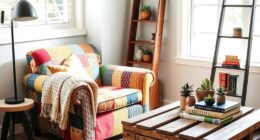Batik is more than just a pretty decoration; it serves as a form of storytelling that has the power to transform your space. Each original design carries rich symbolism, reflecting cultural values and heritage. Patterns such as Parang and Kawung bring themes of strength and prosperity to your interior, blending historical meanings with modern aesthetics. Incorporating batik in cushions, curtains, or framed art can infuse your home with warmth and character. By including these vibrant textiles, you are not only adding style but also a connection to tradition. Explore how this ancient art form can enhance your interior design with a deeper appreciation.
Key Takeaways
- Batik patterns embody cultural heritage and societal values, infusing modern interiors with rich symbolism and historical significance.
- Modern interpretations of batik maintain traditional meanings while appealing to contemporary aesthetics, enhancing decorative versatility.
- Incorporating batik in home decor, such as upholstery and art, adds texture and cultural depth to living spaces.
- Sustainable batik practices are gaining traction, reflecting consumer demand for eco-friendly textiles and supporting artisanal craftsmanship.
- The evolution of batik fosters creativity and storytelling, connecting past traditions with modern design narratives in global interiors.
Origins and Cultural Significance
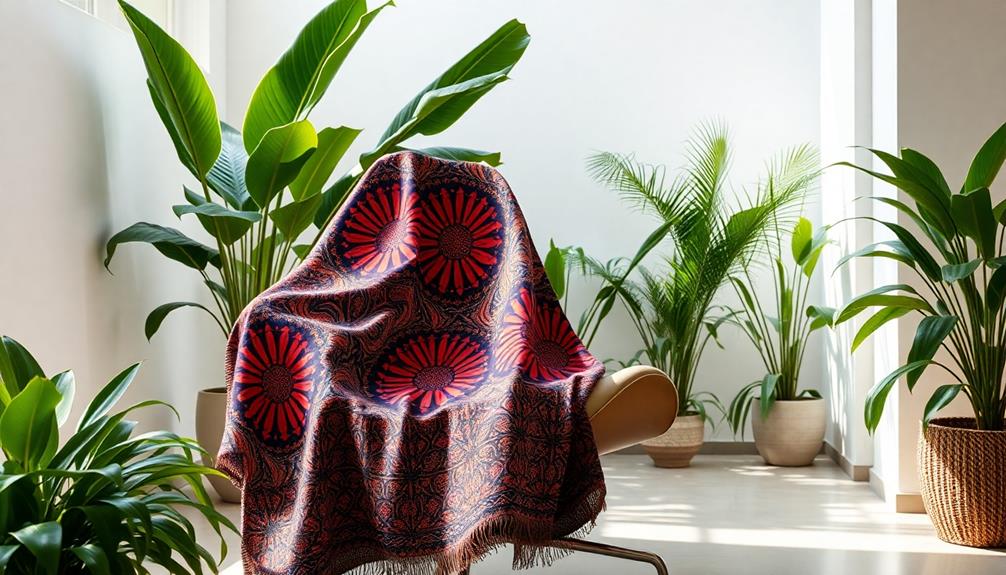
Batik is one of the oldest textile traditions still practiced today, with its origins tracing back to the 6th century in Indonesia. This art form, deeply rooted in Javanese tradition, showcases the beauty of batik through its intricate patterns and rich history. The name "batik" comes from the Javanese word "ambatik," which means cloth with little dots, highlighting the meticulous process behind its creation.
Similar to traditional artistry found in Indonesian decor masks, batik reflects the vibrancy of Indonesian culture.
Indonesian batik isn't just a craft; it's a reflection of cultural heritage and identity. Each batik design carries profound symbolism, with specific traditional patterns representing social status and historical significance. For instance, the parang motif was once exclusively reserved for royalty, illustrating the importance of these designs in conveying societal values.
UNESCO recognizes batik as a Masterpiece of the Oral and Intangible Heritage of Humanity, emphasizing its cultural importance. Batik patterns frequently incorporate local flora and fauna, representing Indonesia's rich biodiversity.
These garments are often passed down through generations, reinforcing familial connections and cultural continuity. As you explore modern interiors, integrating batik can add layers of meaning, connecting you to its vibrant heritage and timeless beauty.
Batik Techniques and Styles
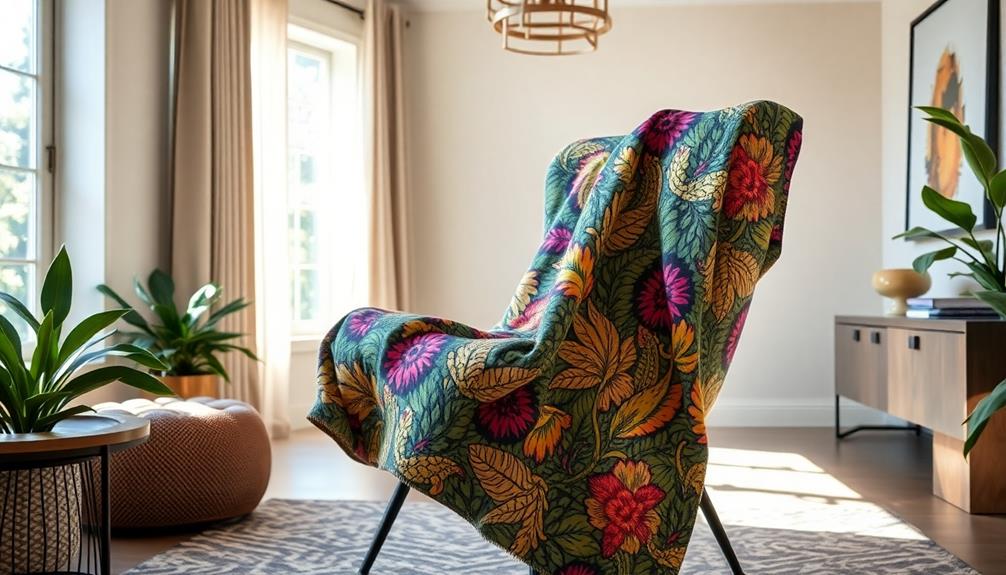
Incorporating batik into interior design not only enhances aesthetic appeal but also showcases the diverse techniques and styles that define this ancient art form. Understanding these batik techniques can deepen your appreciation for their unique charm.
| Batik Technique | Description |
|---|---|
| Batik Tulis | Hand-drawn, the most traditional form of batik. |
| Batik Cap | Stamped method for quicker, intricate designs. |
| Batik Lukis | Involves painting on fabric, allowing creativity. |
| Batik Pesisir | Reflects coastal influences, more commercial. |
| Batik Belanda | Blends Western designs with Javanese techniques. |
Traditional Batik-making uses tools like the canting for detailed wax application and copper stamps for repetitive patterns. You'll find floral imagery prominent in many batik designs, enhancing the emotional connection to nature. The cultural exchange during the Dutch colonial period also introduced new styles, evolving batik art. By embracing these techniques, your interiors can reflect not just beauty but also rich histories and stories woven into each fabric.
Symbolism in Batik Patterns
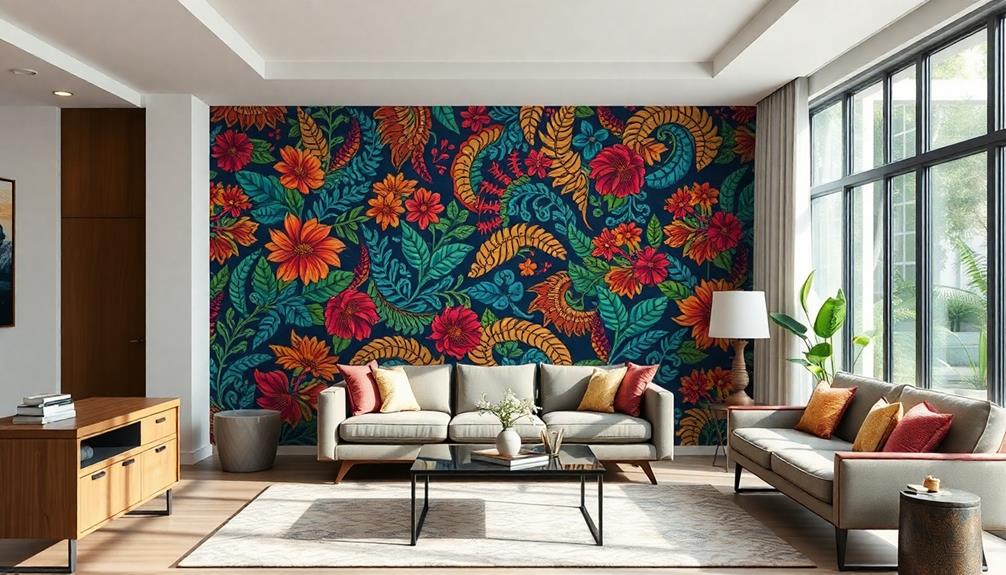
When you explore batik patterns, you'll uncover their rich cultural significance, with each motif telling a story rooted in tradition.
These intricate designs, much like the Indonesian Decor Mask, reflect the artistic expression and craftsmanship of Indonesian culture.
Modern interpretations have breathed new life into these designs, making them relevant in today's interiors while still honoring their historical meanings.
Understanding this symbolism can transform how you perceive and use batik in your own space.
Cultural Significance of Patterns
Patterns in batik are more than just decorative elements; they carry deep cultural significance rooted in Indonesian heritage. Each batik pattern tells a story, reflecting traditional uses and the rich tapestry of Indonesian culture. For instance, the Parang pattern symbolizes power and protection, often linked to royalty, while the Kawung pattern represents fertility and prosperity, echoing ancient Majapahit traditions.
Batik is often incorporated into various home decor items, such as Indonesian decorative pillows, adding both comfort and cultural depth to living spaces.
These beautiful batik designs showcase the symbolic meaning behind each motif, such as the Ceplok pattern, which features geometrical shapes that embody harmony and balance in life. This ancient art form serves not only as a visual delight but also as an artistic expression of identity and values.
In contemporary interior design, modern batik patterns often incorporate contemporary motifs while still preserving their traditional symbolism. This blend appeals to younger generations, making batik relevant in today's world.
UNESCO's recognition of batik as a Masterpiece of the Oral and Intangible Heritage of Humanity further highlights its cultural significance. By integrating these striking batik patterns into your space, you celebrate a legacy that bridges the past and present, enriching your home with meaningful artistry.
Modern Interpretations and Uses
While exploring modern interpretations of batik, you'll find that these patterns continue to resonate in contemporary interiors, marrying tradition with today's design sensibilities. Modern batik designs often incorporate bold, geometric shapes and vibrant color palettes, offering a fresh take on this ancient art form. These patterns can be found on textiles, wallpaper, and even in home décor accessories, adding a touch of cultural sophistication to any space. By seamlessly blending the old with the new, modern batik designs bring a sense of timelessness and global influence to contemporary interiors.
Batik motifs offer rich narratives and symbolic meanings that can enhance your home decor in unique ways, similar to how traditional Indonesian style home decor incorporates local culture and natural materials.
Here are three key aspects to reflect upon:
- Accent Pieces: Integrate batik fabrics as cushions or wall hangings to create focal points that showcase intricate craftsmanship and cultural heritage.
- Symbolic Significance: Patterns like the Parang motif, representing power, or the Kawung, symbolizing prosperity, can infuse your space with deeper meanings and evoke feelings of strength and abundance.
- Muted Palettes: Opt for batik designs in muted tones to complement minimalist decor, balancing vibrant patterns with contemporary aesthetics for an elegant touch.
These modern interpretations don't just celebrate batik's historical roots; they also make it relevant for today's design enthusiasts.
Modern Applications in Design
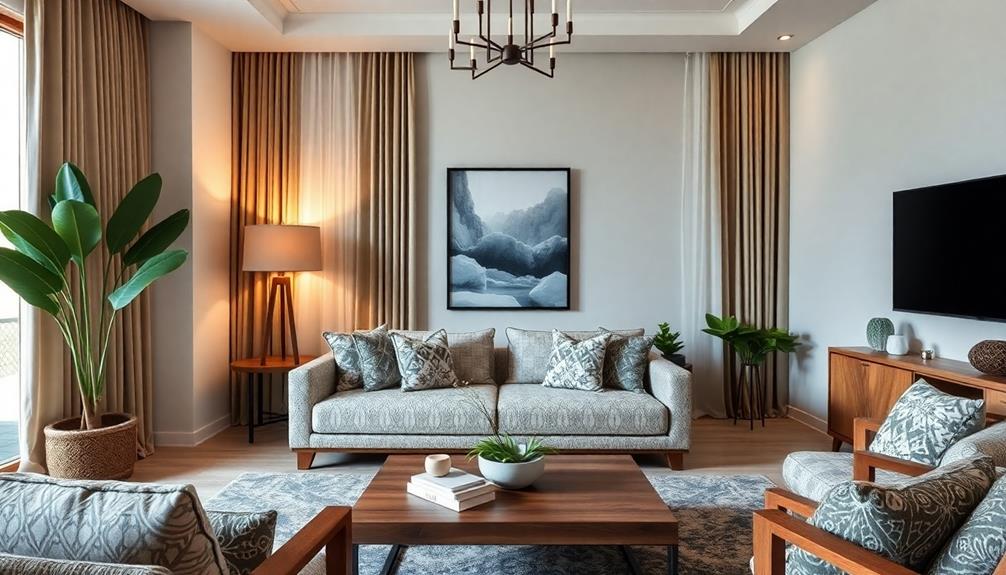
As you explore modern interior design, you'll find batik fabric making a significant impact with its intricate patterns and vibrant colors. This unique material enhances the aesthetic appeal of various spaces, from cozy homes to sleek offices. Designers are creatively incorporating batik into accent pieces like cushions, throws, and curtains, which seamlessly complement both contemporary and traditional decor styles.
Here's a glimpse of how batik fabric is applied in modern design:
| Application | Description | Benefits |
|---|---|---|
| Upholstery | Adds texture and cultural depth to furniture | Unique and inviting feel |
| Framed Art | Serves as striking focal points in spaces | Captures attention and sparks conversation |
| Cushions & Throws | Brings warmth and color to living areas | Cozy, stylish accent pieces |
| Curtains | Enhances natural light while maintaining privacy | Elegant and functional |
| Textile Brands | Offers luxury batik-inspired options | Supports sustainability and handmade artistry |
The versatility of batik fabric, along with its emphasis on sustainability, resonates especially with younger generations seeking authentic decor.
Incorporating Batik in Interiors
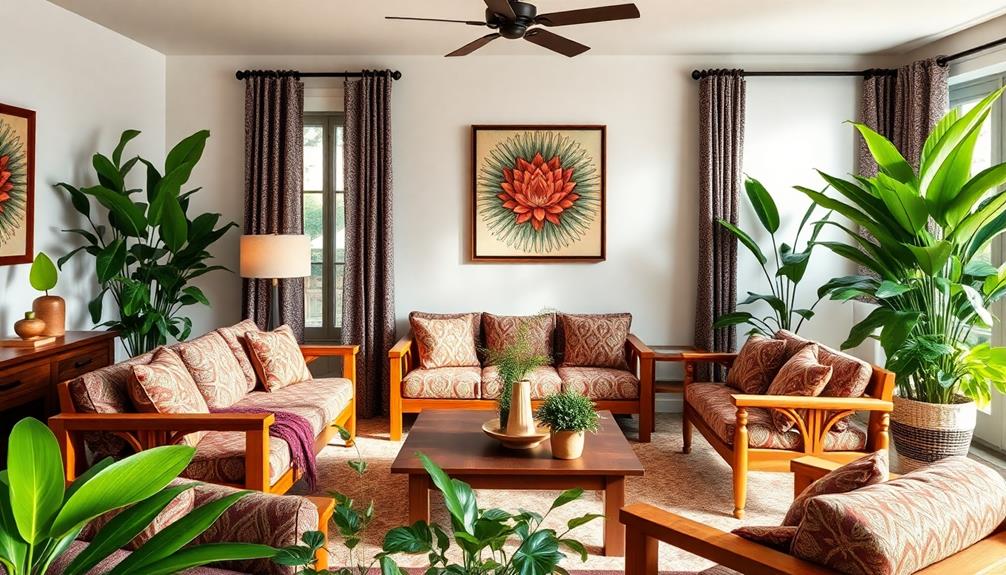
Incorporating batik into your interior design can transform a space with its rich symbolism and vibrant colors. By using batik patterns, you're not just adding decor; you're infusing your home with cultural depth and artistic flair.
Additionally, the use of Indonesian decor masks alongside batik elements can create a cohesive cultural theme. Here are three effective ways to integrate batik into your interiors:
- Accent Pieces: Cushions, throws, and curtains featuring unique batik designs can enhance your overall aesthetics while showcasing traditional craftsmanship. These pieces can easily complement various modern styles.
- Wall Decor: Framed batik art serves as stunning wall decor, allowing you to display intricate designs and the stories behind each piece. It becomes a conversation starter, adding personality to your space.
- Upholstery: Using batik in upholstery provides texture and a distinctive element that balances modern and traditional styles. A batik-patterned chair or sofa can be a striking focal point in any room.
Future Trends in Batik Art
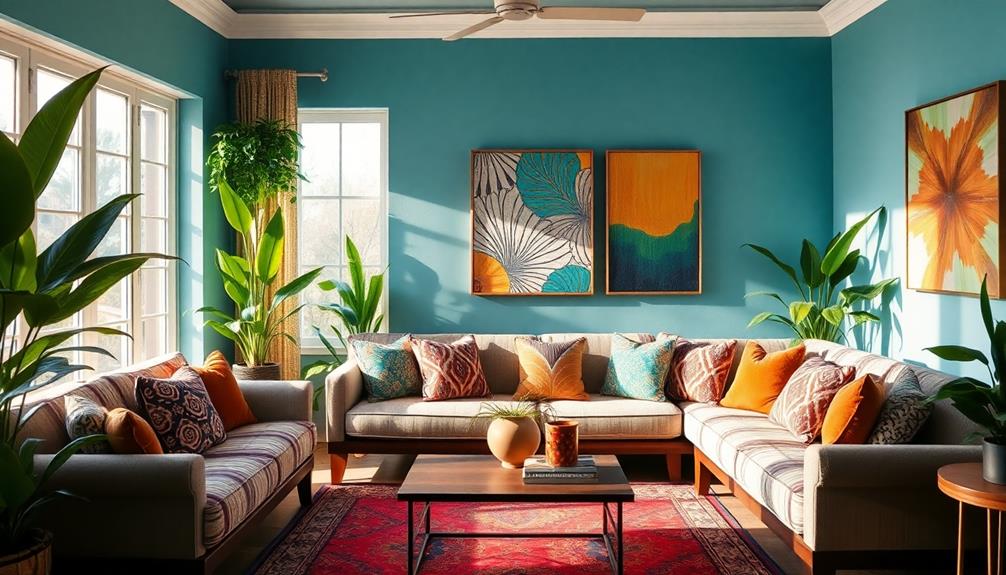
Batik art is evolving, and its future looks promising as it gains global recognition. You'll notice a significant shift towards sustainability, with consumers increasingly favoring eco-friendly batik textiles.
Contemporary batik designers are creatively merging traditional techniques with modern motifs, making batik more appealing to younger generations interested in fashion and home decor. This movement aligns with the principles of Balinese Interior Design, which emphasizes natural materials and eco-friendly practices.
Online workshops and communities are popping up, fostering an environment of learning and innovation. This trend encourages new artists to experiment with batik, guaranteeing the craft remains vibrant and relevant.
Institutions like the Batik Guild in London and the Pekalongan Batik Museum play vital roles in promoting batik's rich cultural significance and hidden symbolism, connecting past traditions with contemporary applications.
Moreover, batik's versatility is showcased in luxury textile brands and at high-profile design events, highlighting its adaptability within the modern design landscape.
As batik continues to evolve, it not only preserves its heritage but also embraces a future where sustainability, innovation, and creativity thrive. This combination guarantees that batik remains a powerful medium for artistic expression and cultural storytelling in the years to come.
Frequently Asked Questions
What Does Batik Symbolize?
Batik symbolizes power, protection, and prosperity through its intricate motifs. Each design tells a story, reflecting cultural identity and heritage. You'll find it embodies tradition while appealing to contemporary aesthetics, enriching spaces with meaning and depth.
Why Is Batik so Special?
Batik's special because it combines artistry, culture, and history in each unique design. You're not just wearing or displaying fabric; you're embracing a rich tradition that tells stories and connects you to heritage.
What Is the Meaning of Batik in Art?
Batik in art represents cultural identity, storytelling, and heritage. Each intricate pattern you see conveys unique meanings, enriching your understanding of the artwork's significance while celebrating local wisdom and traditional craftsmanship through vibrant designs and colors.
How Is Batik Used in Everyday Life?
Imagine wrapping yourself in vibrant batik patterns; you wear them as dresses or shirts. You also adorn your home with batik curtains and cushions, blending tradition into your everyday life, enriching your personal style.
Conclusion
By embracing batik's rich tapestry of symbolism and artistry, you're weaving a piece of history into your modern interior. It adds an enchanting layer, transforming spaces into vibrant narratives that speak to both tradition and innovation. As you incorporate these exquisite patterns, you're not just decorating; you're inviting a conversation that dances between the past and present. So go ahead, let batik's charm breathe life into your home, creating a delightful atmosphere that feels both timeless and invigoratingly contemporary.






